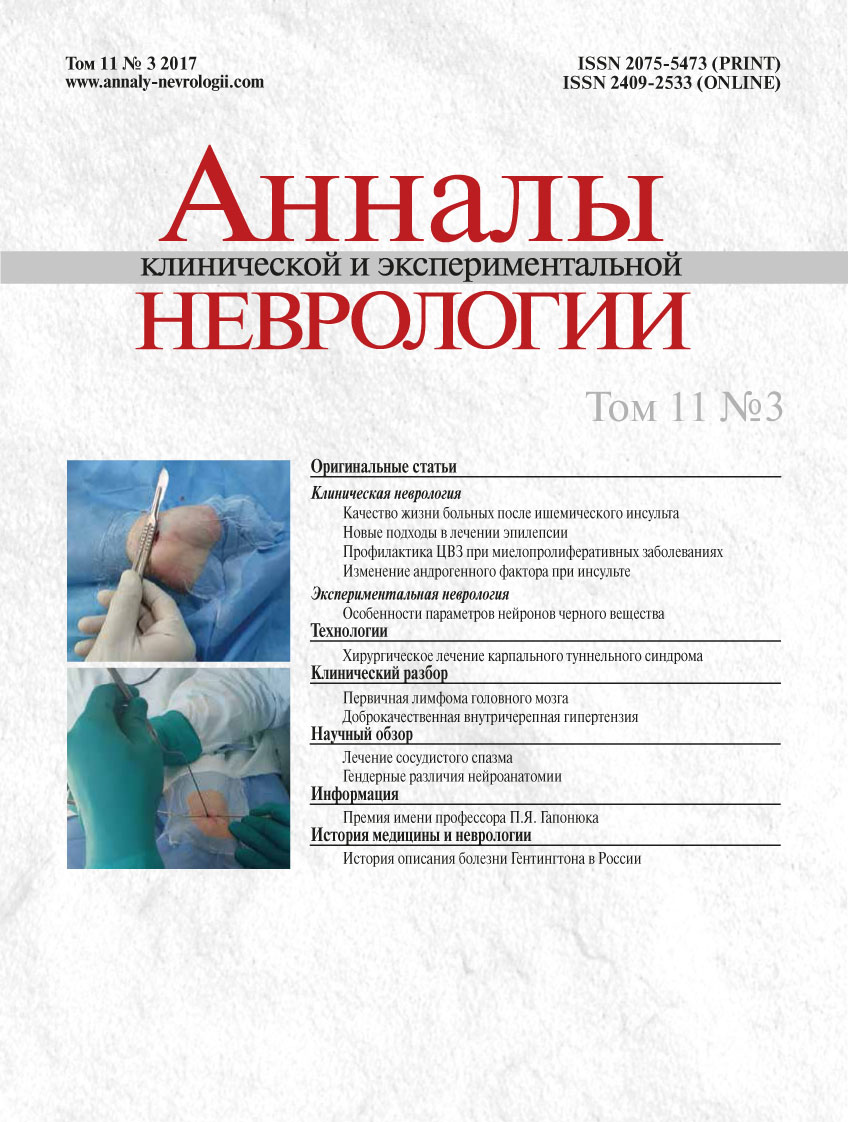Качество жизни как интегральный показатель реабилитации больных в восстановительном периоде ишемического инсульта
- Авторы: Лукьянчикова Л.В.1, Бельская Г.Н.1
-
Учреждения:
- ФГБОУ ВО «Южно-Уральский государственный медицинский университет» Минздрава России
- Выпуск: Том 11, № 3 (2017)
- Страницы: 5-14
- Раздел: Оригинальные статьи
- Дата подачи: 28.09.2017
- Дата публикации: 28.09.2017
- URL: https://annaly-nevrologii.com/journal/pathID/article/view/482
- DOI: https://doi.org/10.17816/ACEN.2017.3.1
- ID: 482
Цитировать
Полный текст
Аннотация
Введение. Ишемические инсульты приводят к временной или стойкой утрате трудоспособности вследствие развития очаговой неврологической симптоматики. Изучение качества жизни является важным критерием эффективности реабилитационных методик и оценки интегрального показателя общего состояния здоровья после сосудистой катастрофы.
Цель исследования. Оценка качества жизни у пациентов в восстановительном периоде полушарного ишемического инсульта в течение года как интегрального показателя эффективности комплексной реабилитации.
Материал и методы. Были обследованы 123 больных в возрасте от 40 до 80 лет с ишемическим инсультом, в остром и реабилитационном периодах (до 1 года). Оценивали неврологический статус пациентов (шкала Бартела, модифицированная шкала Рэнкина, шкала NIHSS), качество жизни (общий опросник жизни SF-36) в остром периоде и после курса реабилитационного лечения.
Результаты. После санаторного лечения у больных регистрировалась положительная динамика во всех сферах, определяющих качество жизни, включая эмоционально-личностную сферу, в первые 3 месяца после перенесенного ишемического инсульта. Соблюдение индивидуальной программы реабилитации на амбулаторном этапе приводит к явной положительной динамике основных показателей неврологического статуса, опросника SF-36, формирует высокоадаптивные формы отношения к болезни в течение года.
Заключение. В течение первого года у пациентов, перенесших легкий и средне-тяжелый ишемический инсульт выявлено восстановление самообслуживания, функциональной независимости, показателей физического и психического компонентов здоровья по опроснику SF-36, регресс очаговой неврологической симптоматики.
Ключевые слова
Об авторах
Лариса Владимировна Лукьянчикова
ФГБОУ ВО «Южно-Уральский государственный медицинский университет» Минздрава России
Автор, ответственный за переписку.
Email: lvl_med@mail.ru
Россия, Челябинск
Галина Николаевна Бельская
ФГБОУ ВО «Южно-Уральский государственный медицинский университет» Минздрава России
Email: lvl_med@mail.ru
Россия, Челябинск
Список литературы
- Vetrov A.V., Bodrova I.V., Borisova A.V. et al. [Medical rehabilitation of patients with ischemic stroke, the recovery period in a rehabilitation unit]. In: [Medical prevention, rehabilitation medicine and spa at the turn of the III-rd millennium. Collected papers of the international scientific-practical conference]. 2016: 104-105. (in Russ.).
- Kosivtsova O.V. [Keeping patients in the recovery phase of stroke]. Neurology, neuropsychiatry, psychosomatics. 2014; (4): 101-105. (in Russ.).
- Carod-Artal F.J., Egido J.A. Quality of life after stroke: the importance of a good recovery. Cerebrovasc Dis. 2009:27 Suppl 1:204-14. PMID: 19342853 doi: 10.1159/000200461.
- Kelly-Hayes M. Influence of age and health behaviors on stroke risk: lessons from longitudinal studies. J Am Geriatr Soc. 2010; 58 Suppl: 325-328. PMID: 21029062 doi: 10.1111/j.1532-5415.2010.02915.x
- Lavreneva K.N, Bavykin M.V. [Information collection performance of medical organizations and health of the population of the Chelyabinsk region for 2015.] Chelyabinsk; 2016: 47, 56. (in Russ.).
- Bekbosynov A.Zh. [Influence of conservative treatment on quality of life of persons with ischemic stroke]. Vestnik Kyrgyzsko-Rossiyskogo slavyanskogo universiteta. 2013; 13(1): 140-143. (in Russ.).
- McCluskey A., Ada L., Middleton S. et al. Improving quality of life by increasing outings after stroke: study protocol for the Out-and-About trial. International Journal of Stroke. 2013; 8(1): 54–58. PMID: 23280270 doi: 10.1186/s12913-015-0952-7.
- Dolgova N.Yu., Vorontsov S.A., Kirichenko O.V., Makarova I.Yu. [Rehabilitation treatment of neurological patients in the sanatorium.] Kremlevskaya meditsina. Klinicheskiy vestnik. 2013; (4):53-56. (in Russ.)
- Katona M. Predictors of health-related quality of life in stroke patients after neurological inpatient rehabilitation: a prospective study. Health Qual. Life Outcomes. 2015; (13): 58. PMID: 25971254 doi: 10.1186/s12955-015-0258-9.
- Tian Y., Hassmiller Lich K., Osgood N.D. et al. Linked Sensitivity Analysis, Calibration, and Uncertainty Analysis Using a System Dynamics Model for Stroke Comparative Effectiveness Research. Med Decis Making. 2016; 36(8): 1043-57. doi: 10.1177/0272989X16643940. PMID: 27091379.
- Trekin S.V. [Evaluation of neurological disease severity scales and their comparison with the degree of violations statodynamic function]. Mediko-sotsial'naya ekspertiza i reabilitatsiya. 2013; (1): 11-16. (in Russ.).
- Dhamoon M.S., Moon Y.P., Paik M.C. et al. Quality of life declines after first ischemic stroke. The Northern Manhattan Study. Neurology. 2010; 75(4):328-34. PMID: 20574034 doi: 10.1212/WNL.0b013e3181ea9f03. 13. Roche N. Auto-rehabilitation at home for stroke patients. Ann Phys Rehabil Med. 2016; (59):38. doi: 10.1016/j.rehab.2016.07.088.
- Ermakova N.G. [Features sick person with the effects of stroke in a patient rehabilitation]. Izvestiya Rossiyskogo gosudarstvennogo pedagogicheskogo universiteta im. A.I. Gertsena. Psikhologiya. 2008; (68): 32-42. (in Russ.).
- Parkhomenko A.A. [Health care organization in cerebral infarction: a modern condition, especially outpatient]. Saratovskiy nauchno-meditsinskiy zhurnal. 2015; 11 (2): 100-106. (in Russ.).
- Parshina V.V. [Social and labor rehabilitation of stroke]. Aktual'nye problemy gumanitarnykh i estestvennykh nauk. 2015; 11(7): 152-155. (in Russ.).
- Giaquinto S., Giachetti I., Spiridigliozzi C., Nolfe G. Quality of Life After Stroke in a Rehabilitation Setting. Clinical and Experimental Hypertension. 2010; 32(7): 426–430. PMID: 20874223 doi: 10.3109/10641961003667963.
- Solonets I.L., Efremov V.V. [Quality of life as a predictor of the effectiveness of rehabilitation of post-stroke patients]. Fundamental'nye issledovaniya [Fundamental research]. 2013; 12(1): 76-80. (in Russ.).
- Irimia A., Van Horn J.D. Systematic network lesioning reveals the core white matter scaffold of the human brain. Front Hum Neurosci. 2014; (8): 51. doi: 10.3389/fnhum.2014.00051. PMID: 24574993.
- Nichols-Larsen D.S., Clark P.C., Zeringue A. et al. Factors influencing stroke survivors' quality of life during subacute recovery. Stroke. 2005; 36(7):1480-4. doi: 10.1161/01.STR.0000170706.13595.4f. PMID: 15947263. 21. Portegies M.L., Koudstaal P.J., Ikram M.A. Cerebrovascular disease. Handb Clin Neurol. 2016; 138: 239-61. PMID: 27637962 doi: 10.1016/B978-0-12-802973-2.00014-8
- Ronning O.M., Stavem K. Determinants of change in quality of life from 1 to 6 months following acute stroke. Cerebrovascular Diseases. 2008; 25(1-2): 67-73. doi: 10.1159/000111524. PMID: 18033960.
- Novik A. A., Ionova T. I. Rukovodstvo po issledovaniyu kachestva zhizni v meditsine. 2-e izdanie [Guide to the study of quality of life in medicine. 2nd edition]. Shevchenko Yu. L. (eds.) Moscow. ZAO «OLMA Media Grupp», 2007: 320p. (in Russ.)
- Belova A.N. Shkaly, testy i oprosniki v meditsinskoy reabilitatsii [Scales, tests and questionnaires in medical rehabilitation]. Belova A.N., Shchepetova O.N. (eds.) Moscow. Antidor, 2002: 440p. (in Russ.)
Дополнительные файлы









